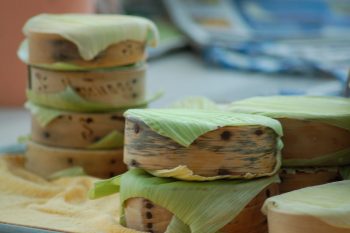Mexico and its Cheeses Posted by Karoly Molina on Aug 22, 2019 in Uncategorized
When we think of cheese, our minds usually think of France, the Netherlands and Italy (to name a few), but much less to Mexico. However, Mexico boasts of some delicious cheese that complement Mexican cuisine quite well. In this post, I would like to explore the queso tradition in Mexico with four of its varieties: queso Oaxaca, queso panela, and queso de bola.
Historia
Mexico’s history with cheese began after la Conquista Española in the 16th century. Cattle or ganado was unknown to the Americas before the Spanish. The Spanish introduced their dairy traditions including cheese making. Later on, other countries influenced cheese-making in Mexico with all sorts of developments. Most of the cheese made in Mexico is queso fresco or cheese that has not been left to age. These cheeses can’t be stored for long periods of time and have a milder flavor than the aged counterparts. Most cheese sold at major grocery stores is made with pasteurised milk, however, unpasteurised cheese can still be found in markets and local farmer shops.
Queso Oaxaca
Known as queso oaxaca, quesillo or queso trenzado, this is perhaps one of the most popular cheeses. It is made with leche de vaca pasteurizada or pasteurised cow’s milk and is easy to shred. It is the choice of cheese for quesadillas thanks to its mild flavor and ability to melt quickly. Quesillo was first made in Oaxaca with a similar method as that of the Italian mozarella, but using the available cow’s milk.
Because of its mild flavor, quesadillas with queso Oaxaca taste great with added ingredients such as flor de calabaza or zucchini flowers, huitlacoche which is a type of corn fungus that is safe to eat, and Poblano peppers.
Queso panela
Queso panela is perhaps one of the healthiest cheese options out there. This queso fresco does not melt and adapts well to other flavors. It is often used as an appetizer or to snack on and can also be sprinkled on top of enchiladas and sopes. The flavor of queso panela is so versatile that it can also be served as dessert together with ate or quince.
Queso panela is also sometimes called queso de rancho. Queso de rancho is the name given to a very wide variety of cheeses made in similar fashion to that of panela, but in a more rustic style. The milk isn’t always pasteurised and is sometimes mixed with goat’s milk giving it a more complex flavor.
The following video shows how one of the biggest dairy companies in Mexico, Lala, makes this food staple!
https://youtu.be/lHbU1kZkcII
Queso de bola
Queso de bola is the one Mexican cheese that most resembles its inspiration. This cheese is also known as queso holandés and is basically the typical Dutch cheese called Edam that we all know and love. The cheese is made with cow’s milk and has a red wax covering. This cheese first came to the Mexico via the state of Yucatán and, thanks to its economical price, became very popular. Eventually, the cheese made its way around the country, and is now a staple in Mexican food.
Two of the most popular dishes with this cheese are the queso relleno and las marquesitas. Queso relleno is exactly that: the cheese filled with a mixture of ground pork, onion, peppers, olives and capers. You can see the full recipe in this page by Larousse Cocina. The other popular recipe with queso de bola is for marquesitas which is a type of crepe filled with cheese. You can see how the marquesitas are made in the video below.
Both the queso relleno and the marquesitas have become so popular that just last week, a group of Mexican chefs were invited to the annual cheese festival in Edam, the Netherlands to prepare authentic dishes from Yucatán that showcase the diversity of the cheese in the Mexican cuisine. The video below explains what the group of chefs will do and what the aim of the project is.
Are you familiar with the different varieties of Mexican cheeses? Which one is your favorite cheese or your favorite Mexican dish with cheese?

Build vocabulary, practice pronunciation, and more with Transparent Language Online. Available anytime, anywhere, on any device.





